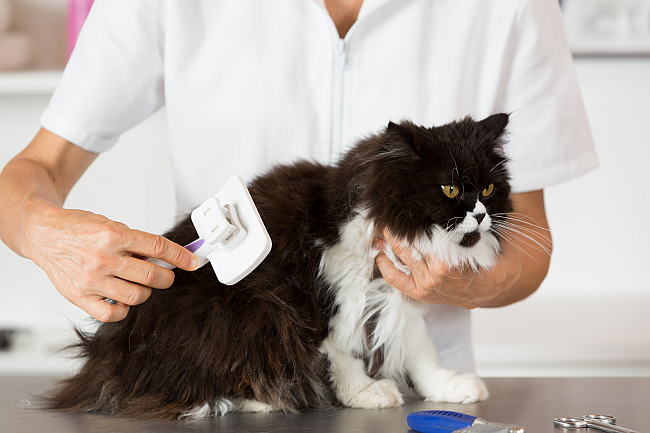
Cats make grooming look effortless. But the human involvement required with keeping a feline’s coat and physical appearance intact is far more hands-on and challenging than simply licking one’s fur into place. Here are some helpful tips about grooming a long-haired cat’s coat.
Tips for Grooming Long-Haired Cats At Home
Handling: If you don’t get this part down, then grooming may be a frustrating struggle every time you pick up a comb. Start training your cat to accept handling as early as you can, as this will make him more receptive to being held, brushed, groomed, bathed and preened whenever it is time to work on his coat. Do this by practicing holding him, stroking his feet, toes, limbs, ears and head. (We also advise getting the feline accustomed to having objects such as tooth brushes, and fingers in his mouth. This will make daily dental hygiene practices, handling and grooming much more palatable to him.)
Brushing: Before you pick up the brush, it is important to recognize, there is a right way and a wrong way to brush your cat. Begin slowly, observing your cat’s reactions. Try to take note if there are any “sensitive” areas to avoid. Usually, the underbelly tends to be ticklish for cats, so proceed with caution until you know your cat’s comfort level.
Using a thick brush, work in downward motions over the legs and chest, always going with the grain of the fur on the back, sides of the cat and the tail. Over the head/neck consider using a short comb with very gentle pressure around the face.
If your long-haired cat is a heavy shedder, we recommend using a FURminator brush to rid the kitty of loose fur on the outer and inner coat. After the brushing session, use a wipe to move over the surface, and pick up any straggling hairs or dandruff along the way.
Tip: To make brushing easier, add a fish oil or a vitamin E supplement to your kitty’s diet to keep her fur nice and healthy. A well-moisturized scalp will make brushing a smoother process and will minimize excess shedding.
De-tangling: One of the downsides of working with a long-haired cat, is that they are more likely to develop mats. If in the course of brushing you come across a tangled area, be careful not to pull forcefully in the hopes that the brush prongs will remove the snarl. This could cause your cat pain, or cause him to scratch or snap at you. Rather, hold the hair down close by the root, so as to limit the pain of pulling the skin directly, and work a wide-toothed comb through the matted part bit by bit until the knot separates. If your cat seems squirmy or uncomfortable, move on to smoother sections of his coat, and come back to the area later. If the mat won’t budge, some pet parents have found detangling sprays, spray conditioners, a bit of coconut oil (or even cornstarch powder) will lubricate or loosen the hair enough to remove knots.
Trimming: While many feline owners will defer hair trimming to the professionals, it is possible to do so at home. If you have blunt-tipped pet hair clippers or electronic trimmers, then the process is fairly simple. When you take your cat to the groomers, talk to them about the best ways to “clean up” the hair by hand with scissors. Then ask their advice on what setting to put electronic clippers on. Watch how they work through the cat’s fur to get a nice even cut.
Then when you are at home (after you have brushed the cat, and worked through any tangles), have your pet stand up on all four legs if possible. Practice giving the kitty a good hair trim based on the techniques shown from your groomer. We do not recommend “eye-balling it” if you want the fur to come out evenly. If you feel particularly unsure of yourself, there are tutorial videos online about how to trim a long-haired cat at home.
Be prepared: since cats are living creatures that might get restless or fidgety, proceed cautiously, looking out for sudden movements while you have the razor in hand.
Tip: Use a low-speed when working around the cat’s ears and face, as this is usually much quieter and less disconcerting for the pet.
When in doubt, take the cat to the groomer, and observe their approach, care, handling and techniques so you can practice these at home the next time you work with your long-haired kitty!

